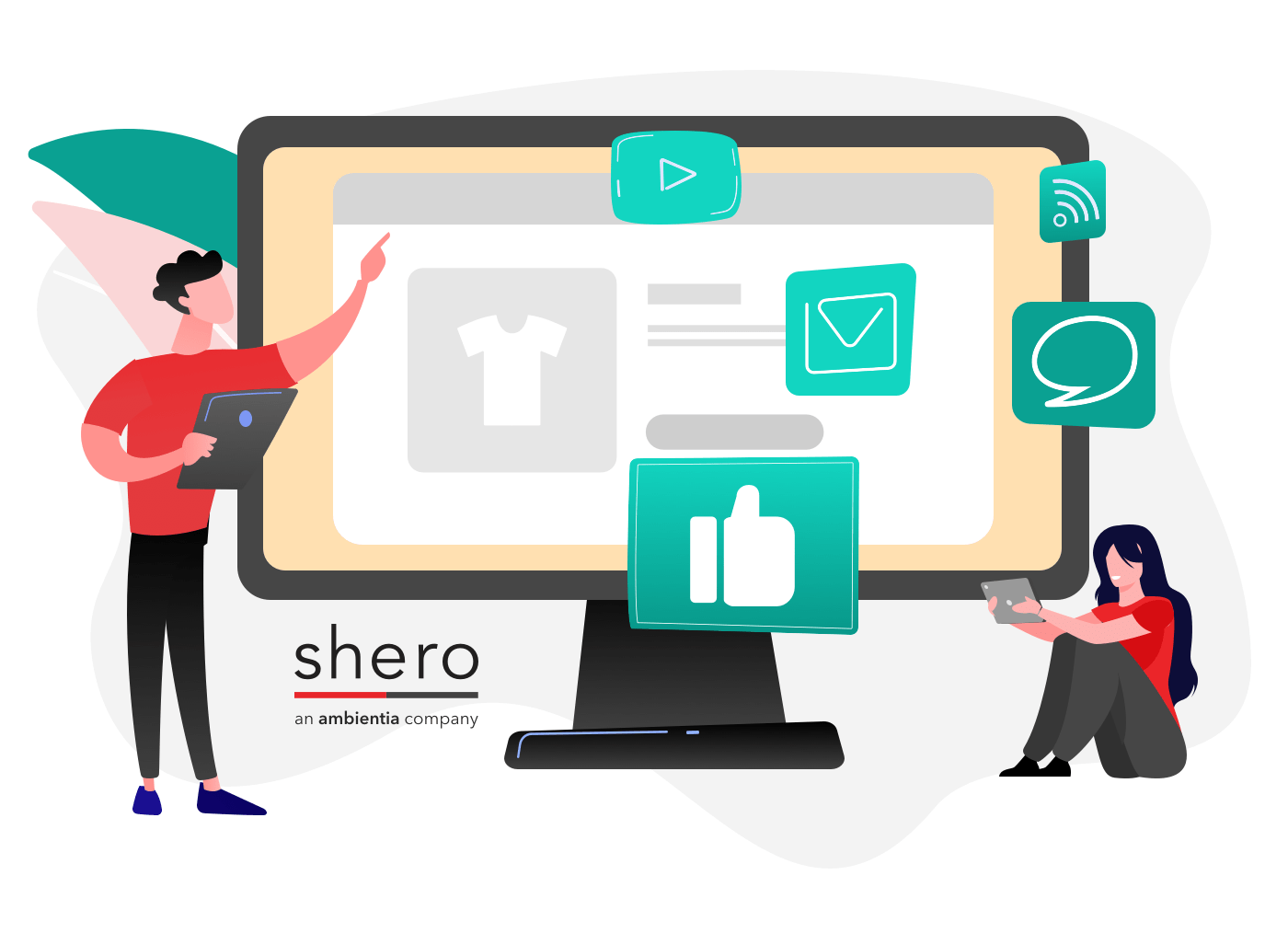The eCommerce industry is a wide-open market. Recent advances in technology have removed many barriers to entry into the digital marketplace, and just about anyone can launch their own web store.
But this coin has another side. The accessibility of the market has led to a flood of new online retailers, dramatically increasing competition and marketing noise across the internet. As opening your own eCommerce store becomes easier, creating and sustaining long-term growth becomes more difficult. Choosing not to have an eCommerce store, though, is becoming riskier by the day. Online shopping has become commonplace, and many shoppers already expect their favorite brick-and-mortar businesses to also sell online. So how can you give your shoppers what they want in this increasingly crowded marketplace? As a business owner, what exactly does it take to successfully add e-tail to your retail?
The good news is, your experience running a physical store automatically gives you several advantages over internet-only merchants. A physical store carries with it a look and a feeling. It has customers with specific needs and products curated to your customer base. Your store is the physical representation of a brand, and you’ve doubtless already invested time and heart into establishing your brand’s identity. A good portion of your work is already done.
In this blog post, we’ll outline how to take full advantage of that head start. By combining your established brand identity with thoughtful strategy and skillful execution, you can branch into this new marketplace and capture new audiences never before reachable.
Phase One: The Devil’s In The Details
So you’ve decided to launch a web store to compliment your existing brick-and-mortar store. There are a few important initial details to consider. Paying attention to the details as you set up your new eCommerce store will put you in a better position as your business grows—and will likely save you quite a bit of money and hassle in the meantime.
Domain Name
First you need a domain name. The domain name is essentially the digital version of your building address; it tells customers where to find you. It should directly relate to your brand and be easy for your customers to remember. For example, if your brand name is “Widgets Galore,” you’d want a domain name like widgetsgalorestore.com.
This may seem obvious, but putting sufficient thought and planning into the details will pay off. Consider this scenario: You purchase the perfect domain name and find an eCommerce platform that fits your needs and budget. But after you’ve established your site, you realize the platform and plan you’ve picked requires you to use a predetermined domain name. Missteps like that can cost you a lot of time, hassle, and frustration.
Site Platform & Software
Your eCommerce platform is another element to approach thoughtfully. We’ve seen many web hosting and site building platforms spring up recently. These new technologies make it very easy to launch an eCommerce website, but which one is best for your eCommerce site? How do you choose, and what should you consider?
The answers will vary from business to business. Finding the right eCommerce platform is the most important stage to invest in, so do your research. If your domain name is your digital address, your platform is your digital building site. Research it as thoroughly as you would if you were scouting a new location for your brick-and-mortar business. Check out documentation and support forums. Talk to an eCommerce consultant.
Finding the right eCommerce platform is the most important stage to invest in, so do your research
One rule holds true for both brick-and-mortar and eCommerce businesses: Moving sucks. Migrating all of your product details and inventory from your physical store to your online store, or from one platform to another, can be time-consuming, tedious, and expensive. Your platform should be able to scale with your business for at least three to five years. So it’s critical to define your current needs and to accurately forecast your needs for the future. Avoid outgrowing your platform early by investing in accurate growth projections before making any platform decisions.
There are two important questions to ask yourself at this stage: What do you need your website to do? And what would you like your website to do? Once you have these questions answered, you can begin researching and comparison shopping.
Platform Extensions, Plugins, Apps, & Third-Party Services
First, find a platform that can meet your needs—those things you can’t compromise on. Then explore the available extensions, apps, or plugins that are compatible with the platform.
Extensions, plugins, and apps are different names for similar tools: they’re software additions designed to accomplish certain tasks the platform itself does not provide. Some are produced by the parent company as a specialized add-on, and some are written by third-party vendors. Some are free, some require a one-time payment, and some work on a monthly subscription model. Accurately defining your needs and wants will help you project cost.
You’ll also need to consider the third-party software services your eCommerce operation will require. Common third-party services include shipping software, tax application software (especially important for international orders), marketing software, and customer service software. Just like your eCommerce platform, each of these software services will have unique functionalities. Again, clearly defining your needs during this stage—and delineating between needs and wants—will clarify your operational expenses.
Phase Two: Post Launch Strategy
In the early years of eCommerce, opening an online store nearly guaranteed that you’d make money. This is no longer true; the landscape has simply become too competitive. However, there is still a great deal of opportunity to make money online; it just requires a lot more work.
Successful eCommerce is a direct result of a successful digital marketing strategy.
Much of that work will be in marketing. Successful eCommerce is a direct result of a successful digital marketing strategy. Once your online store is live and fully optimized, it’s time to begin executing your long-term marketing strategy. Digital marketing includes many components, and there are thousands of tools and services available to help your business grow. Regardless of what tools or approaches you use, no digital marketing strategy is complete without three basics: email marketing, content marketing, and pay per click marketing (PPC).
Email Marketing Software
Email marketing is the most powerful form of online marketing available to internet retailers. This classic form of marketing consists of two simple components: your email address database and your email campaigns. But before we jump into strategy, let’s talk briefly about email marketing software.
Just like eCommerce platforms, your options for email marketing software can seem endless. Functionality varies from bare-bones email delivery to full scale marketing and business intelligence environments. Selecting the right service for your business is crucial. Once again, defining your specific goals, wants, and needs will prove invaluable in the long run.
Your Email Address Database
Your email address database is simply a list of people who receive your emails. Growing your database is a critical part of your overall email marketing strategy. Eventually, this list will represent around 25% of your total online revenue.
There are many different ways to grow this database, but as the owner of a physical store, you’ve got a huge advantage over online-only merchants: You’ve already got customers, and customers who shop in your physical store are usually easily converted into digital customers. All you have to do is collect email addresses in your store. Many retail POS systems already offer this functionality, so it’s simply a matter of asking for an email address during checkout. This is an incredibly efficient way to grow one of your biggest digital marketing assets.
Email Campaigns
So now you have an ever-growing list of high-value customers. But what are you sending them? Your email marketing campaigns represent an important touchpoint with your most valuable customers. These are people who have opted in to your mailing list; they’ve already said yes. This means they feel a connection to your brand and your products. So it’s important to reciprocate by making sure every campaign provides value in one of two forms: either promotional value or compelling and useful content.Everyone loves a good deal. Keep the goodwill flowing by periodically offering your subscribers a tempting promotion. Good deals not only drive sales; they also keep your customers engaged. After all, even the very best email is only successful if subscribers open it.
Valuable content works in a similar way but without the product discount element. If the content you deliver to your customers is compelling, your customers will find value in the correspondence, which will deepen their connection with your brand. For example, if you sell spices from around the world, delivering delicious recipes including your products is a great way to serve your customers while at the same time subtly suggesting a purchase.
Content Marketing
Content marketing is a relatively new component of digital marketing. This phenomenon has been largely driven by increased competition in the digital marketplace. To deal with the flood of new retailers, Google has made it a priority to deliver the most relevant and most valuable results for every search query.
For example, let’s say you sell unique socks. The competition in this segment of the digital marketplace is fierce. To get that coveted first-page ranking for Google search results, you’ve got to stand out; you must be more relevant and offer more value than your competition. How do you do that? By executing a strategic long-term content marketing plan.
To use content marketing successfully, you must identify and develop the kind of content your customer will find compelling, and then create that content consistently. Reliability is an important factor here. We recommend creating a content marketing calendar and sticking to it. This ensures that you’re regularly releasing new content that’s both valuable and relevant for the season and shopping cycle.
The important thing to remember about content marketing is this: It’s a long-term strategy designed to establish your site as an authority on your subject matter—in our example, unique socks.. The more compelling your content is to your niche audience, the more equity you establish. Google’s algorithms will realize that when customers find your site, they spend time there consuming the content—articles, blog posts, video or photo stories—and will begin to recognize your site as a valuable resource for your audience. You’ll be rewarded by moving up in Google search results.
This takes time. It requires constantly developing new content, and then analyzing user behavior and content performance to identify what your audience considers valuable. Many brands rely on third parties to help them create strong content marketing strategies and then execute them by developing new content.
Pay Per Click Marketing
In simple terms, Pay Per Click (or PPC) marketing involves creating ads via an ad platform like Google AdWords or Google Shopping, and then bidding on the cost you’re willing to pay to get your ad displayed when searchers use particular keywords. Google assesses your bid along with other factors like your site’s relevancy and value, compares it to all the competitors bidding on that particular keyword, and then awards the winner a space as a “Sponsored Listing” on the search results page.
You may wonder, if my listing will show up as a Sponsored Listing anyway, why bother with PPC marketing? There are two distinct benefits:
- Direct Benefits: Increased Traffic and Conversions
If the shopper does click on your ad, you’ve increased traffic to your site. You now have the opportunity to make a sale, gain a new mailing list subscriber, or provide valuable information to the shopper. These are direct benefits.
Depending on the goals you’ve defined for your PPC campaign, each of those results can be considered a conversion. Site traffic and conversions are directly related; the more traffic you get, the more conversions you’ll see. As you track user performance and analytics over time, you’ll gain insight into how they’re related for your specific site, and that information can help you further refine your PPC strategy. Site traffic from PPC campaigns also has a positive impact on how Google ranks your relevancy. And again, the more relevant Google thinks your site is, the better your search result rankings will be. - Indirect Benefit: Ad Impressions & Brand Exposure
Even if a shopper doesn’t click on your ad, you’ve still gotten your name in front of them. This is called an “ad impression.” The shopper now knows your brand exists and that you sell what they’re looking for. This could lead to a later visit and eventually even a sale. These benefits aren’t direct, but they do pay off over time.
PPC marketing is very nuanced and requires constant optimization. Strategies vary widely from business to business, especially because the associated cost is a constantly moving target. However, if you develop a thoughtful PPC strategy, pay close attention to results, and then optimize your campaigns over time, the return on ad spend can be terrific.
Before you begin launching PPC campaigns, it’s critical to research what keywords you should bid on and analyse your competition’s ad strategies. This is an area where enlisting an eCommerce partner like Gauge can be invaluable. Agencies bring expertise and exposure to a wide variety of strategies. An agency partner can save you significant time and money you’d otherwise spend on optimizing your strategies through trial and error.
To Succeed in eCommerce, Follow the Formula
Successful eCommerce may not be as instant as it once was, but it’s still pretty formulaic. The principles are simple: Use your brick-and-mortar assets wisely. Practice eagle-eyed attention to detail. Plan diligently and execute consistently. Outdo your competition with content that’s more relevant and valuable than theirs.
Perhaps most importantly, remember that long-term success requires continual investments of time, money, and work. The investments you make during planning will greatly increase your chances of creating and sustaining long-term growth. And don’t shy away from enlisting help. At Gauge we’ve helped many brick-and-mortar retailers make the successful transition to eCommerce. If you’re interested in how we can help you, contact us today.
Gentian, CSO and co-founder of Shero Commerce, guides the company and client digital strategies. He's an expert in technical SEO, Inbound Marketing, and eCommerce strategy.






